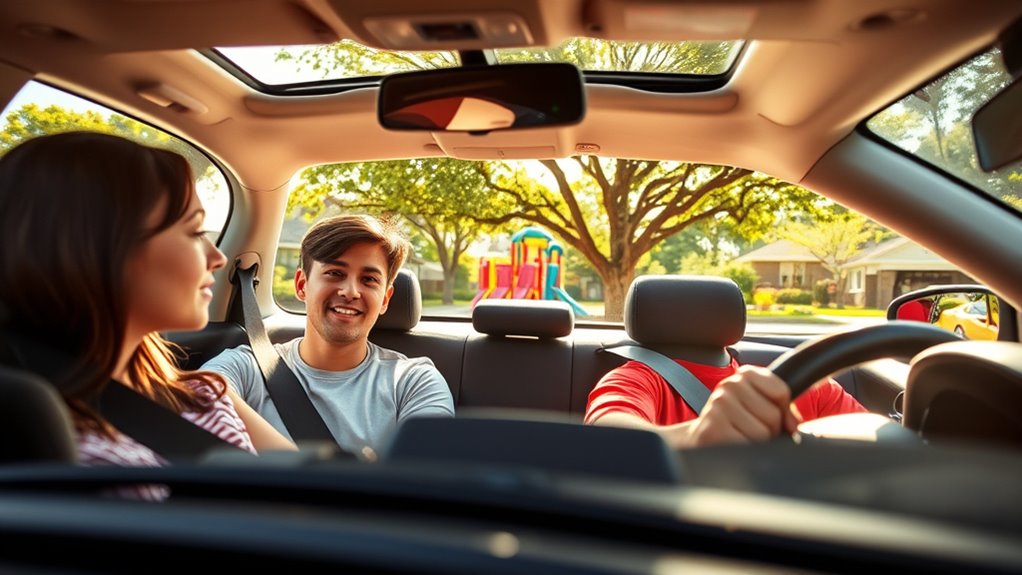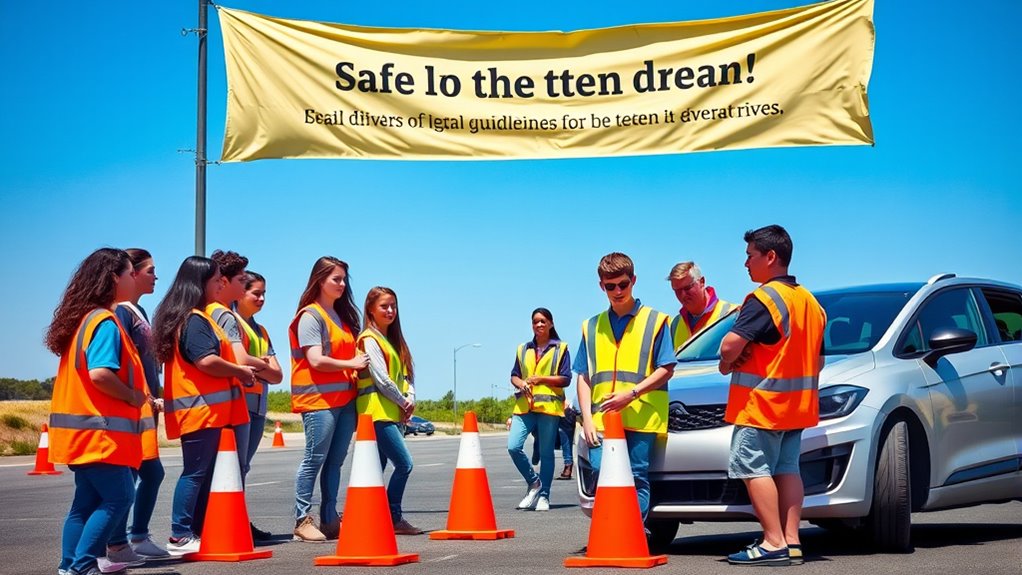Preparing teens for safe driving is crucial since motor vehicle crashes are the leading cause of death for this age group. Start by discussing driving responsibilities and setting clear expectations. Encourage defensive driving techniques and limit distractions. Gaining experience in different conditions can increase their confidence. Remember, establishing safe habits now can reduce risks later. If you want to learn more about protecting young drivers, keep exploring the essential strategies and tools available.
Key Takeaways
- Engage in early conversations about driving responsibilities and safety to prepare teens before formal driver education begins.
- Choose a comprehensive driver education program that aligns with your teen’s learning style and state requirements for effective training.
- Practice driving in various conditions to build confidence and ensure teens are comfortable with different road scenarios.
- Set clear expectations regarding curfews, passenger limits, and safe driving habits to encourage responsible behavior behind the wheel.
- Model safe driving practices consistently and maintain open communication about experiences to reinforce positive driving behaviors in teens.
Understanding the Importance of Teen Driving Safety

Understanding the importance of teen driving safety is crucial, especially since motor vehicle crashes are the leading cause of unintentional injury deaths among teens aged 15-19 in the U.S.
The fatal crash rate for drivers aged 16-19 is nearly three to four times higher than for those 20 and older. Inexperience plays a major role in these alarming statistics, as young drivers often struggle with critical decision-making on the road. Teen drivers have crash rates nearly four times those of drivers 20 and older per mile driven.
Graduated driver licensing (GDL) programs help mitigate these risks by gradually introducing driving privileges. Additionally, proper driver education is essential for ensuring teens learn safe driving habits.
Identifying Common Risks for Young Drivers

Identifying common risks for young drivers is essential for promoting safety on the road. Inexperience plays a significant role in high crash rates among teens, as they often struggle with driving skills and understanding traffic rules. You might overestimate your abilities, leading to risky behaviors like speeding or distracted driving. Using cell phones or having teen passengers can divert your attention and increase the likelihood of accidents. Additionally, nighttime driving poses extra hazards due to limited visibility. Alcohol and substance use, while less common, drastically raise the risk of fatal crashes. Furthermore, male youth are at a higher risk of fatal accidents, which underscores the importance of tailored safety measures. Recognizing these risks is the first step toward safer driving practices and making informed decisions behind the wheel. Stay aware, stay focused, and always prioritize safety.
Strategies to Enhance Safe Driving Practices

To tackle the risks young drivers face, implementing effective strategies for safe driving practices is essential.
Start by mastering defensive driving techniques; always anticipate hazards and maintain a safe distance from other vehicles. Stay alert and be ready to react in emergencies. Defensive driving involves being aware of potential hazards on the road, which can help prevent accidents.
Avoid distractions—put away your phone, limit passenger interactions, and don’t eat while driving. Following traffic laws is vital; obey speed limits and always use turn signals.
Regular vehicle maintenance can’t be overlooked—check tire pressure, verify safety equipment works, and have a spare tire ready.
Finally, gain practical experience by driving in various conditions and practicing tricky maneuvers. Regular driving sessions will build your confidence and help you stay safe on the road.
The Role of Parents in Teen Driving Education

As teens commence their driving journey, parents play an essential role in shaping their attitudes and skills behind the wheel. Start early conversations about driving responsibilities and road safety before formal education kicks off. Choose a thorough curriculum that fits your teen’s learning style and state requirements. Stay engaged by reviewing course materials and discussing their progress regularly.
Provide hands-on practice in various driving conditions to build their confidence. Schedule practice sessions that incorporate both day and night driving experiences to ensure they are well-prepared for all scenarios. Set clear expectations, like curfews or passenger limits, to encourage responsible driving.
Be a role model by practicing safe driving habits consistently. Communicate openly about your experiences and reinforce the importance of safe behavior, helping your teen develop the necessary skills for independent driving.
Key Statistics on Teen Driving Incidents

Motor vehicle crashes claim the lives of nearly 3,000 teens each year in the U.S., making it the leading cause of death for those aged 15-19.
In 2022, teen drivers aged 15-19 were involved in 7% of all fatal crashes, totaling 2,883 incidents. Surprisingly, they hold just 5% of driver licenses but accounted for 8.1% of fatal crashes.
The risk peaks at age 19, with nearly three times the likelihood of a fatal crash compared to drivers 20 and older.
Distracted driving and speeding are major factors, contributing to 28.9% and 30% of teen crashes, respectively.
Weekends and late-night hours pose heightened risks, with over 45% of fatalities occurring between 9 pm and 6 am.
Legal Frameworks Supporting Teen Driver Safety

While steering through the challenges of teen driving, understanding the legal frameworks in place to enhance safety is vital.
Graduated Driver Licensing (GDL) laws, present in all U.S. states, provide a structured approach to obtaining a driver’s license. These laws typically involve three stages: Learner’s Permit, Intermediate License, and Full Licensure, each aiming to reduce high-risk driving scenarios.
You’ll notice significant differences among states, like age requirements and restrictions on cell phone use, with 37 states banning it entirely for novice drivers.
Parental involvement is important, too; parents need to guarantee teens complete supervised driving hours and adhere to GDL requirements.
Building Confidence Through Practical Experience

Building confidence behind the wheel starts with practical experience in a variety of driving environments.
Begin in empty parking lots to master basic skills like steering and parking. Move on to quiet residential streets to get comfortable with real-road conditions without heavy traffic. Once you’re confident, practice on low-speed roads to refine merging and lane changes.
Gradually introduce moderate traffic and tackle more complex scenarios like highways and busy intersections.
Don’t forget nighttime driving and practicing in different weather conditions, as these experiences enhance adaptability. Consistent short practice sessions, totaling around 30-50 supervised hours, reinforce your skills.
Set realistic milestones to track progress, and remember, open communication about fears helps create a supportive learning environment.
Frequently Asked Questions
What Should Teens Do if They Feel Unsafe Driving at Night?
If you feel unsafe driving at night, trust your instincts.
Pull over to a well-lit area, stay calm, and assess the situation.
If you’re too anxious to continue, call a trusted friend or family member for help.
Always keep your phone handy for emergencies.
Consider waiting until you feel more comfortable or ask someone to drive you.
Prioritize your safety, and don’t hesitate to seek assistance if needed.
How Can Teens Handle Peer Pressure While Driving?
Maneuvering the road’s twists and turns is like steering through the unpredictable waters of peer pressure.
When you’re behind the wheel, set clear boundaries with your friends before you drive. Trust your instincts and practice assertiveness to resist distractions.
Choose your passengers wisely, limiting their number to reduce chaos. Utilize apps that keep your phone in check, and educate your friends about the dangers of risky driving.
This way, you can steer clear of trouble.
What Are the Best Ways to Minimize Distractions While Driving?
To minimize distractions while driving, you should limit phone use, only using it for emergencies.
Set clear rules, like prohibiting teen passengers initially to reduce distractions.
Eat before you drive, avoiding any manual activities like eating or grooming.
Use pre-programmed GPS or voice commands for navigation, keeping your eyes on the road.
Stay focused by minimizing conversations and managing environmental distractions, ensuring every drive is as safe as possible.
How Can Teens Prepare for Adverse Weather Conditions While Driving?
Picture yourself maneuvering a slippery, snow-covered road—preparation is key.
To get ready for adverse weather, practice driving in safe environments, like an empty parking lot. Create an emergency kit with essentials. Always clear snow off your vehicle for visibility.
In rain, slow down and keep your headlights on. Stay alert around intersections and avoid flooded areas.
What Should Parents Do if Their Teen Gets Into a Minor Accident?
If your teen gets into a minor accident, first confirm everyone’s safety by moving vehicles if possible.
Call the authorities to report the incident and assess any injuries.
Exchange information with other parties involved, and document the scene with photos.
Stay calm to help manage emotions, listen to your teen’s concerns, and avoid assigning blame.
Finally, consider seeking legal advice if necessary and discuss the importance of safe driving practices moving forward.
Conclusion
To summarize, prioritizing proactive practices for teen driving safety is essential. By combining careful coaching, consistent communication, and constructive experiences, you can help your teen navigate the road with confidence. Remember, it’s not just about the rules; it’s about fostering a fearless and focused mindset. With your support, your teen can transform into a responsible driver, ready to tackle the twists and turns of the road ahead. Together, let’s drive towards a safer future!









